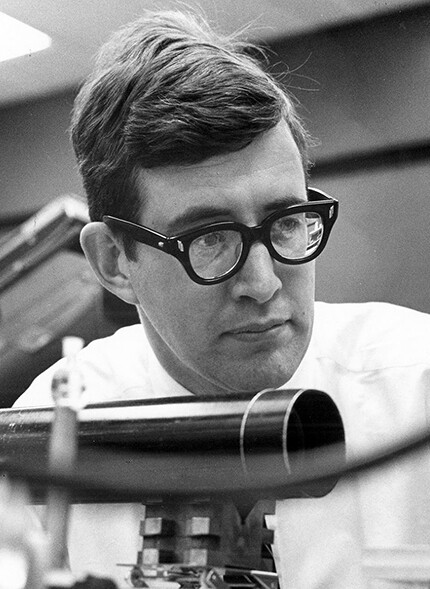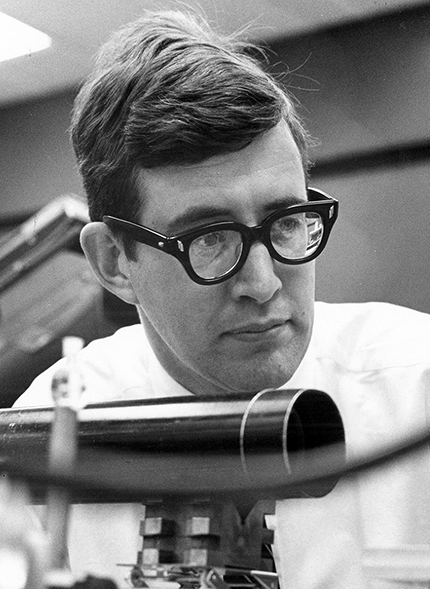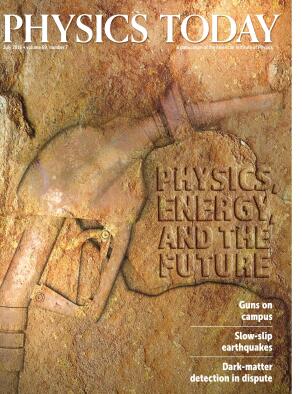Peter Pitirimovich Sorokin
DOI: 10.1063/PT.3.3245
Peter Pitirimovich Sorokin, a renowned trailblazer in laser science, died on 24 September 2015 in Danbury, Connecticut, from injuries suffered during a fall a month earlier. An IBM fellow emeritus, he devoted his scientific career to discovering new coherent light sources and using them to probe novel physical phenomena.

Peter Pitirimovich Sorokin
COURTESY OF THE IBM CORPORATION

Peter was born on 10 July 1931 in Boston and grew up in nearby Winchester. He attended Harvard University, where he received a BA in 1952 and a doctorate in applied physics in 1958 under the direction of Nicolaas Bloembergen.
That same year Peter joined a small group at IBM. Led by William Smith, the group had been studying a relaxation mechanism important to the operation of microwave masers. Peter considered Smith’s suggestion that certain material systems might lead to IR or optical masers. Arthur Schawlow and Charles Townes had recently derived a simple, explicit rate-equation formula applicable to a general system operating in the IR and visible regions and gave the minimum rate at which atoms must be supplied in an excited state for coherent light generation to occur.
Peter identified trivalent uranium and divalent samarium as two promising four-level ionic systems in calcium fluoride that possessed the required luminescence and absorption properties, and he proceeded to work on a total-internal-reflection laser design. Theodore Maiman reported on optical laser action in ruby in June 1960, however, months before Peter received his fabricated samples. So Peter had his samples refabricated into rods with parallel, silvered ends. When pumped by a xenon flashlamp, the cryogenically cooled rods operated as the world’s first four-level lasers (the second and third lasers ever developed), with threshold pumping energies much smaller than ruby’s. Peter’s demonstration became a basis for practical lasers.
In 1964 Peter became interested in the spectral properties of organic dyes, which led to his discovery of the saturable-dye Q-switch, the first passive device used to produce “giant” laser pulses. The switch subsequently was widely applied to mode-locked laser sources and enabled ultrafast pulse generation.
Peter had on hand a supply of photochemically stable phthalocyanine dyes and was thus familiar with their singular spectral features. In 1966 he explored the use of concentrated solutions of chloro-aluminum phthalocyanine for stimulated Raman scattering, pumped by a Q-switched ruby laser, and also the direct generation of stimulated emission from the dye, with a ruby laser as a fast optical pump. On analyzing the emission, Peter found that stimulated emission had occurred—the dye laser had been discovered. He and his colleagues subsequently showed the potential impact of the device, with its wide spectral range and tunability; that impact was further advanced by Peter’s demonstration of efficient lasing when the dye is pumped with incoherent light from flashlamps. His discovery is extraordinarily significant: Dye lasers revolutionized optical spectroscopy and nonlinear optics.
In the decades that followed, Peter and his colleagues developed numerous innovative techniques for studying chemical dynamics. With characteristic originality, Peter conceived of approaches for obtaining an entire transmission spectrum—from the IR to the UV—with a single laser pulse at tens of femtoseconds time resolution. To realize those approaches, he developed broadband stimulated Raman techniques, nonlinear optical mixing, and amplification of ultrashort UV pulses in excimer lasers; along the way he discovered the UV ultrafast gas-phase supercontinuum. Using ultrafast transmission techniques and time-domain descriptions for transient polarization, he and his colleagues were able to record the wavepacket dynamics of dissociating gas-phase molecules; they showed that the measurement yields both amplitude and phase information and is capable of revealing the system’s nascent dynamics. Up until his death, Peter contemplated novel topics in astrophysics and suggested that coherent, nonlinear, and laser phenomena occur in certain stellar environments, which possibly explains some observed astrophysical spectral anomalies.
Widely recognized for his immense research accomplishments and discoveries, Peter was honored with the Franklin Institute’s 1974 Albert A. Michelson Award, the Optical Society’s 1978 R. W. Wood Prize, the National Academy of Sciences’ 1983 Comstock Prize in Physics, the Technion–Israel Institute of Technology’s 1984 Harvey Prize, and the American Physical Society’s first Arthur Schawlow Prize in Laser Science in 1991.
Peter freely shared credit with others and would often draw attention to under-recognized or shared discoveries. Despite his accomplishments and honors, Peter was modest. Perhaps that was influenced by his early experience in graduate school: “The fact that I almost quit, but then found something just following my own hunches, gave me a lot of confidence, and I’ve retained that confidence all through my career.”
Working with Peter was an absolute joy. Even though he could tire out many with his unbridled enthusiasm, his inquisitive nature and creative energy sparked numerous discoveries and made the scientific journey with him overwhelmingly rewarding.
Aside from his scientific work, Peter loved spending time outdoors. He walked, ice-skated, skied, and hiked whenever he could. He also loved spending summers at the family cabin in Canada and could adeptly cut the grass there using a traditional scythe. Peter enjoyed listening to classical music and often drew inspiration from it. He had a whimsical sense of humor and laughed easily. He is deeply missed by his family, friends, and colleagues.
More about the Authors
James Glownia. US Department of Energy, Germantown, Maryland.
James Misewich. Brookhaven National Laboratory, Upton, New York.




